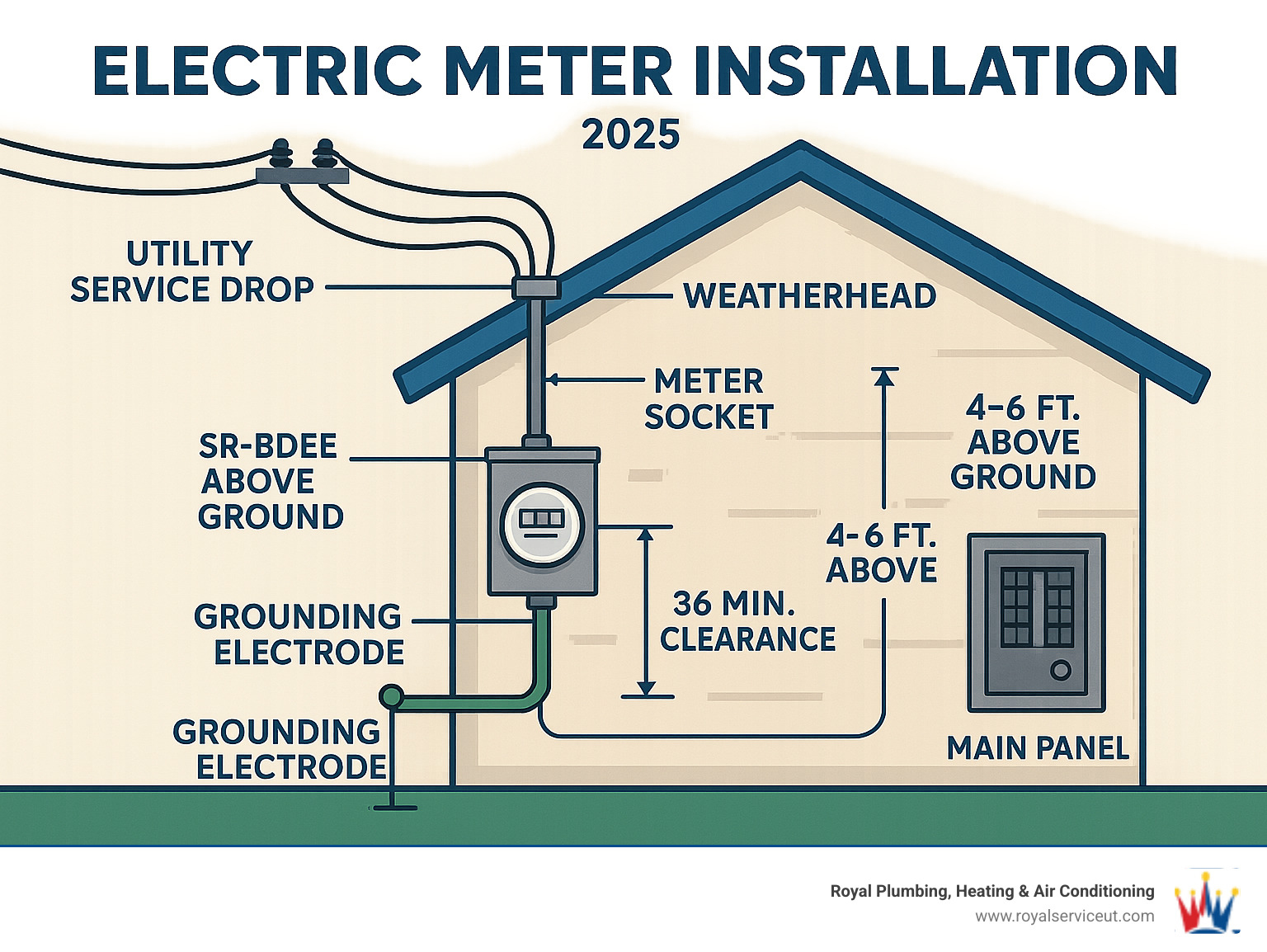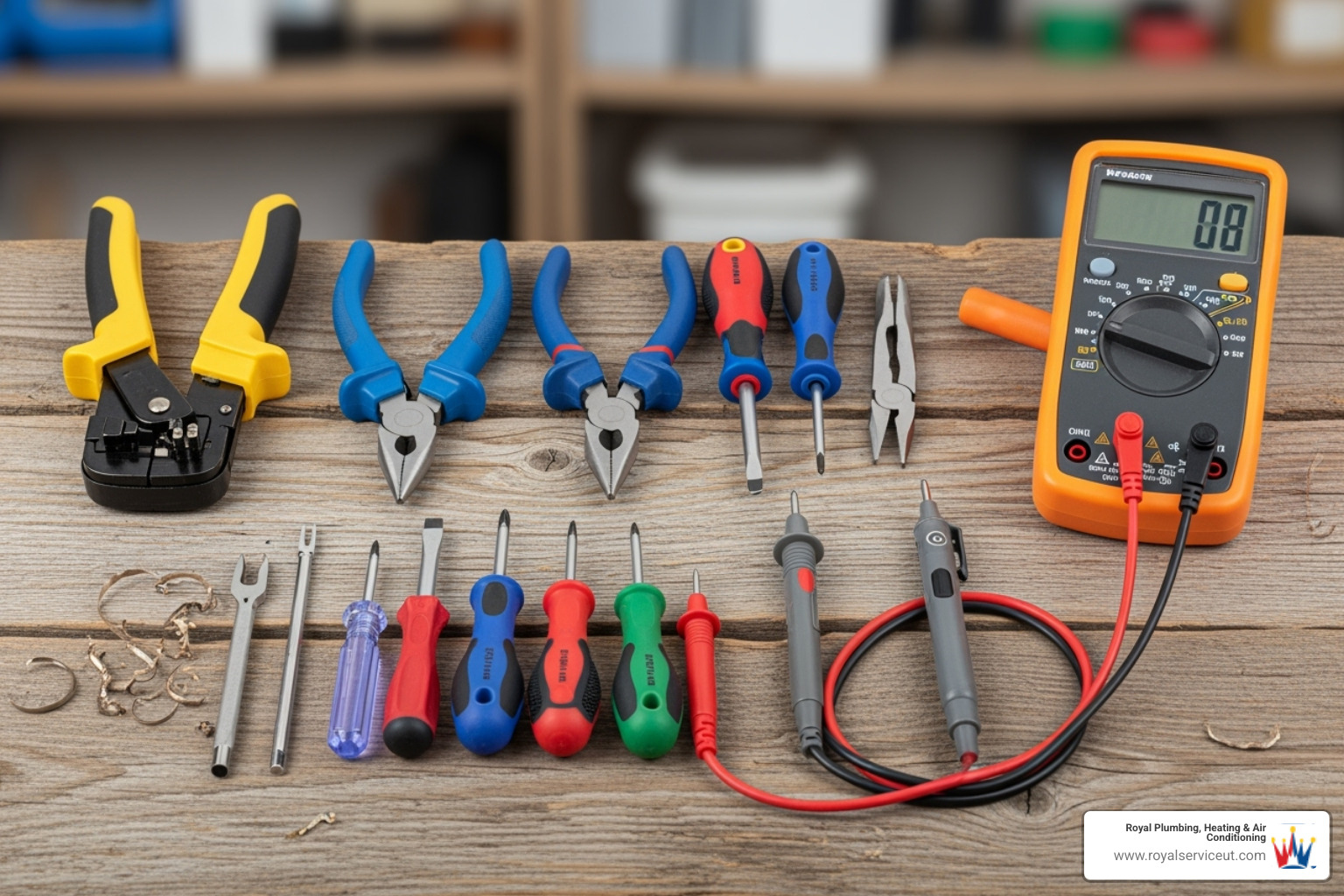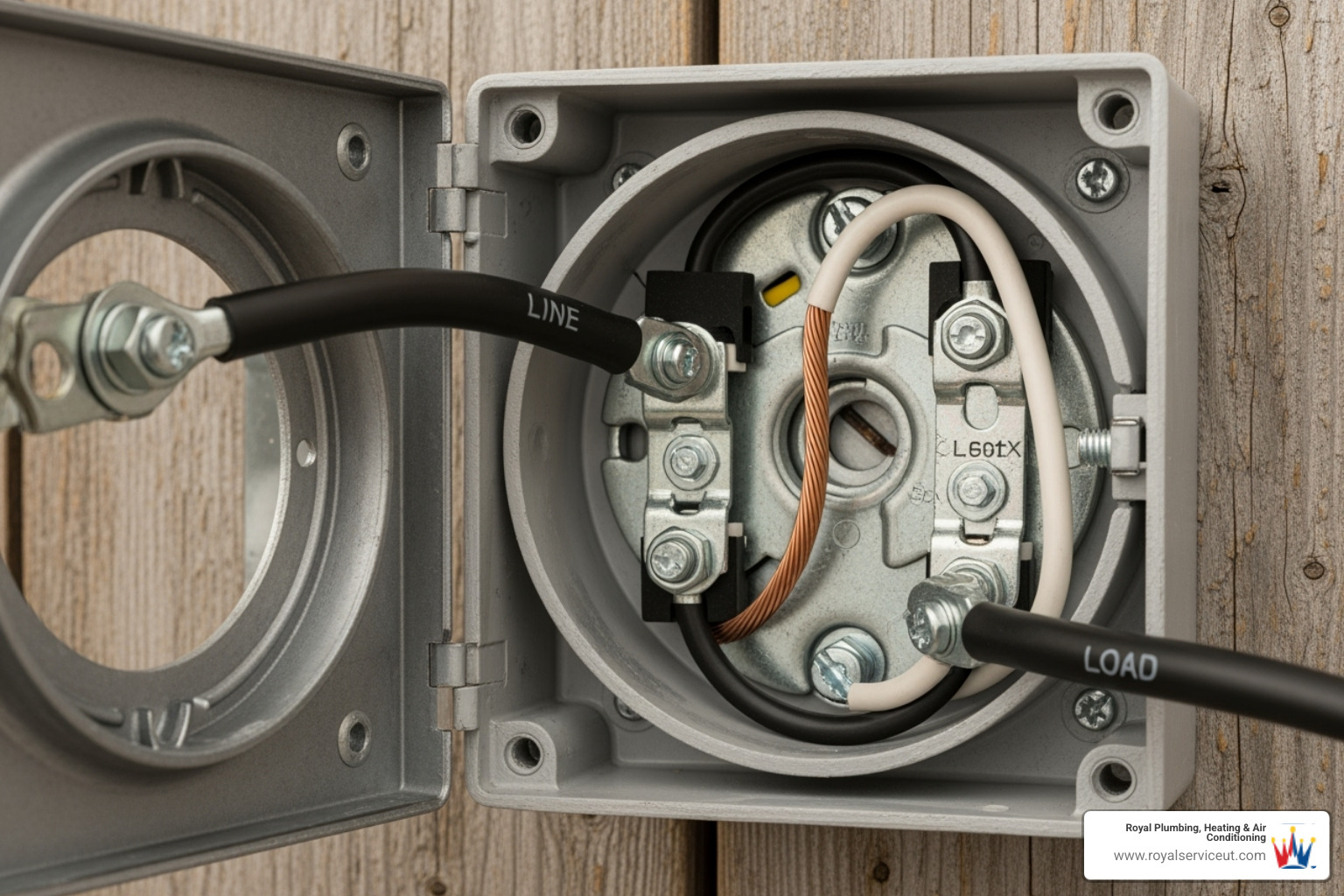Electric meter installation is a critical part of your home's electrical system. It measures power consumption for accurate billing from your utility company. Whether you're building a new home, replacing a faulty meter, or upgrading to a smart meter, proper installation is essential for safety and compliance.
Key Steps for Electric Meter Installation:
Most homeowners need a licensed electrician for meter installation, as it involves working with high-voltage utility lines and must comply with the National Electric Code (NEC). A simple replacement typically takes 15-30 minutes, while new installations require more time and coordination.
Safety is paramount—improper installation can lead to electrical hazards, inaccurate billing, or code violations. While homeowners can do some prep work, the actual meter connection requires a professional to ensure compliance with local Utah codes and utility requirements.

Your electric meter tracks your home's energy usage 24/7, ensuring accurate billing and a safe electrical system. The electric meter box is a critical safety barrier, protecting your home's electrical connections from the elements and ensuring high-voltage connections are secure, weatherproof, and code-compliant.
A properly installed meter base is vital for your safety, finances, and peace of mind.
Accuracy is a key benefit. A secure, level meter measures power consumption precisely, preventing surprise bills from estimated readings or mechanical errors.
Safety is where a proper electric meter installation truly matters. The meter base shields dangerous electrical connections from weather and tampering. A loose base can cause arcing, fires, or electrocution.
Regulatory compliance with the National Electric Code (NEC) and local Utah regulations is essential for safety and valid insurance. It also helps when selling your home.
Power reliability depends on a solid foundation. A wobbly meter base can cause intermittent connections, leading to power fluctuations or outages.
Finally, cost efficiency is improved. Accurate measurements help you track energy use, and reliable connections prevent energy waste.
Modern electric meters offer various levels of sophistication to meet different needs and utility requirements.
Analog meters, found on older homes, use spinning discs to measure electricity. They require manual reading and don't provide detailed usage data.
Digital meters display usage numerically. They are more accurate and often allow for remote reading, eliminating estimated bills.
Smart meters are the current standard for residential digital meter technology. They record usage frequently and transmit data to your utility for accurate bills, better outage detection, and detailed usage insights.
Interval meters record usage at specific times but may lack the advanced communication of smart meters. They are common in commercial settings.
Bi-directional meters for solar are for homes with solar panels. They measure power flow in both directions, tracking grid usage and crediting excess solar power sent back to the utility.
| Feature | Analog Meter | Digital/Smart Meter |
|---|---|---|
| Reading Method | Spinning dial, manual reading | Digital display, often remote reading |
| Accuracy | Good, but susceptible to mechanical wear | Generally more accurate and consistent |
| Data Detail | Total consumption only | Detailed usage patterns, sometimes real-time data |
| Remote Access | No | Yes, allows utility remote monitoring and data collection |
| Modernity | Older technology, less common in new installs | Modern, increasingly standard |
The right meter depends on your utility's requirements and your energy goals. Most new installations use digital or smart meters for their accuracy, convenience, and future-readiness.
Proper preparation is vital for a safe and smooth electric meter installation that meets all regulations. This phase is all about getting organized before any work begins.

Working with your home's main power source demands careful preparation. Safety is the top priority.
First, turning off power is the golden rule. Before touching any wires, cut the electricity at the main breaker. Your utility company will also likely need to disconnect power from their side for the actual electric meter installation. Always confirm power is off with a reliable voltage tester or multimeter before proceeding.
Next, contact your utility provider to inform them of the planned work. They are typically responsible for shutting off power and for installing and sealing the meter after your electrician prepares the meter base. For new services, this is the first step.
Finally, check local regulations and obtain permits. You'll need to check with your local building department for required permits. Adhering to the National Electric Code (NEC) and local guidelines is mandatory. Skipping this step can lead to fines, rework, or unsafe conditions.
Having the right tools makes the installation safer and smoother. Here’s a list of what you’ll typically need:
With preparations complete, here are the general steps for electric meter installation. The actual wiring should always be done by a licensed professional.

Selecting the proper location is critical for accessibility, safety, and compliance.
Next, physically mount the meter base.
This is the most critical and dangerous step and must be performed by a licensed electrician.

The final steps involve testing and coordinating with your utility company.
While DIY projects can be rewarding, electric meter installation is not one of them. This work involves high-voltage electricity and significant safety risks. Always hire a licensed electrician for any work on the meter or service entrance wiring. Your family's safety is paramount.
Several situations require professional electric meter installation.
New construction requires a meter to be installed to connect the home to the power grid, which involves coordinating with the utility and following building codes.
Old meter replacement is necessary for meters with inaccurate readings, blank displays, or mechanical failure. These issues can signal deeper electrical problems.
Upgrading service to a higher amperage for new appliances or a home addition requires upgrading the meter base and wiring. This is a job for a professional.
Installing a sub-meter allows landlords or owners of multi-unit properties to track individual unit usage for accurate billing. This requires professional installation.
Be prepared for common issues like corroded or damaged sockets and insufficient panel capacity. A professional can assess and resolve these problems safely.
Professional installation isn't just smart; it's often legally required for several reasons.
Ensuring compliance with the NEC and local Utah codes is complex. Licensed electricians understand the National Electric Code (NEC) and these regulations, preventing costly errors and ensuring safety.
Handling live utility-side wires is extremely dangerous. The wires from the utility company are live even when your main breaker is off. Working on them without proper training can be fatal.
Liability and insurance are important considerations. Improper electrical work may not be covered by homeowner's insurance. Licensed electricians are insured, protecting you from liability.
Coordinating with the power company is smoother with a professional. They know the protocols for shut-offs, inspections, and sealing, ensuring a hassle-free process.
Guaranteeing a safe and reliable connection is what you get with a professional. They ensure a safe, reliable, and properly grounded connection for efficient electrical service.
At Royal Plumbing, Heating & Air Conditioning, we understand that your home's electrical system is the backbone of your daily comfort. Our experienced team provides comprehensive services across Northern Utah, ensuring your royal comfort with reliable, professional solutions you can trust.
Here are answers to common questions we hear about electric meter installation and what you need to know.
A sub-meter measures electricity usage for a specific part of a property, like a rental unit or workshop. It's installed downstream from the main utility meter and is useful for landlords who want to bill tenants for their exact usage or monitor consumption in separate areas.
Sub-meters must be installed downstream of the main meter, typically on their own circuit with safety devices like an RCD and overload protection. To ensure accuracy and legality, specific MID-certified and STS-compliant meters are often needed. Always consult a licensed electrician for sub-meter installation to ensure it's safe and up to code, and remember to switch off the main circuit breaker before any work begins.
A simple meter replacement or smart meter upgrade is quick, typically taking only 15-30 minutes with a brief power outage of about 15 minutes. A completely new electric meter installation for a new service takes longer and involves more extensive wiring and coordination with the utility company.
To ensure a smooth process for your electric meter installation, provide your electrician or utility company with your full service address, account number (if applicable), and the specific type of service needed (e.g., new installation, replacement, upgrade). Information about your existing electrical panel's amperage and any specific requests or issues is also helpful.
Professional electricians can troubleshoot common issues that arise during an electric meter installation. Here are a few examples:
In all cases, consulting a licensed electrician is the best way to diagnose and safely resolve the issue, keeping your home powered and protected.
We've covered the key aspects of electric meter installation, from understanding meter types to critical safety steps. Proper installation requires careful planning, the right tools, and professional expertise.
Your electric meter is the gateway to the power grid, ensuring accurate billing and a safe, reliable electrical system. Whether you're dealing with a new construction project, replacing an aging analog meter, or upgrading to a smart meter, proper installation is crucial.
Safety must always come first. While homeowners can do some prep work, the actual wiring must be left to licensed professionals due to the extreme risks of working with high-voltage utility lines.
Professional expertise makes all the difference. Licensed electricians have the training, knowledge of the National Electric Code and local Utah regulations, and insurance to protect your investment. They ensure a safe, compliant installation that will serve your home for decades.
At Royal Plumbing, Heating & Air Conditioning, we understand that your home's electrical system is the backbone of your daily comfort. Our experienced team serves communities throughout Northern Utah, from Cache County down to Salt Lake County, bringing the same commitment to excellence whether we're working on your heating system, plumbing, or electrical needs.
When you're ready to move forward with your electric meter installation or any other electrical project, we're here to provide the royal treatment you deserve. Our licensed professionals will handle every detail with care, ensuring your project meets all safety standards while keeping disruptions to your daily routine at a minimum.
More info about our expert electrical services in Salt Lake City
Find answers to frequently asked questions about our services.
By reading this blog post, you will gain valuable insights and knowledge that can help you in your daily life.
The purpose of this blog post is to inform and educate readers about a specific topic, providing them with useful information and tips.
The target audience for this blog post includes individuals who are interested in learning more about the topic and seeking practical advice.
You can apply the knowledge and tips shared in this blog post to your own life by implementing them in your daily routine.
The benefits of reading this blog post include gaining new perspectives, acquiring practical skills, and enhancing your overall knowledge on the topic.
Absolutely! Feel free to share this blog post with your friends, family, or anyone who might find it helpful or interesting.
Yes, the information provided in this blog post is reliable and based on credible sources. We strive to ensure the accuracy and quality of the content we share.
The benefits of reading this blog post include gaining new perspectives, acquiring practical skills, and enhancing your overall knowledge on the topic.
If you have more questions related to the blog post topic, please don't hesitate to contact our team. We're here to help!
We value your feedback! If you have any suggestions, comments, or feedback regarding this blog post, please let us know. Your input is important to us.
Trust our team of dedicated professionals for all your HVAC and plumbing needs.